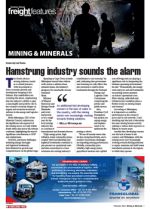In southern Africa's logistics and freight scene, few stories rival the success of the Port of Maputo. Its impressive transformation and efficiency have captured attention locally and internationally.Each year, it continues to make remarkable strides, skilfully handling growing volumes with expertise. Moreover, there are no signs of its pace slowing down as it continues to grow, setting records and reaching new milestones along the way.Osorio Lucas, CEO of the Maputo Port Development Company (MPDC) which operates the Mozambican harbour, remains modest in his reaction to the port's achievements. He attributes the port's successes over the past two decades to the fundamental belief that they are here to serve above all."We have made significant investments in the port's infrastructure and its systems, ensuring maximum efficiency and streamlining. Naturally, our people are a top priority and considerable effort is dedicated to training and skills development," he said during a sit-down interview with Freight News. "But above all, we recognise the fundamental significance of this port and its beneficiaries. Our clients shape our approach. The solutions we provide are crafted with the client at the forefront. I firmly believe in actively engaging with our clients and welcoming their insights and needs. Criticism isn't seen as negative; instead, it's an opportunity to enhance our operations, elevate our standards, and deliver an even better service."The Mozambican government has taken note of this commitment, evidenced in its decision to extend the concession contract with MPDC for another 25 years. It will now run until 2058. MPDC, a private Mozambican company formed through a partnership between Caminhos-de-Ferro de Moçambique (CFM) and Portus Indico, comprising Grindrod, DP World, and Mozambique Gestores, has collectively invested over $800 million in modernising the port's infrastructure to date.With increased capacity reaching 37 million tonnes (mt) through continuous deepening dredging, quay rehabilitation spanning over 1 500 metres, and significant investments in equipment and staff training, the port achieved a record volume last year, handling 31.2mt of cargo. This equates to growth of 16% compared to the previous year."And the investment is far from over," said Lucas. "We intend to inject another €2bn during the extension of our concession period. Our plans entail increasing capacity from 37mt to 54mt by 2058."Expectations for 2024 volume through the port are slightly lower than for 2023 at only 31mt because of a slight capacity loss due to the infrastructure upgrades that will occur in the next few months.Lucas has ambitious plans to bolster mining commodity exports through the port, emphasising the critical need for ports in southern Africa to provide efficient and streamlined services to the sector.However, he underscores that more than port efficiency is needed; railways must also be upgraded in parallel to facilitate seamless transportation. Also, border posts between countries must be geared towards smooth supply chain movement.The port collaborates closely with government service providers, including customs authorities, road transporters, and the railways. "Part of our sustained growth in volumes stems from our perspective of not merely being a port operator, but rather a provider of a comprehensive logistics system from the mining house to the vessel," Lucas explains.Service providers like the port cannot afford to assume they'll always have a steady stream of clients. "We must offer diverse services to keep our clients engaged continuously," said Lucas. "We must invest in enhancing our infrastructure, elevate our performance standards, and consistently refine our operations.”

